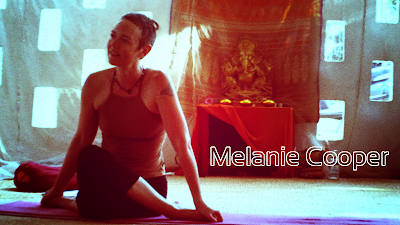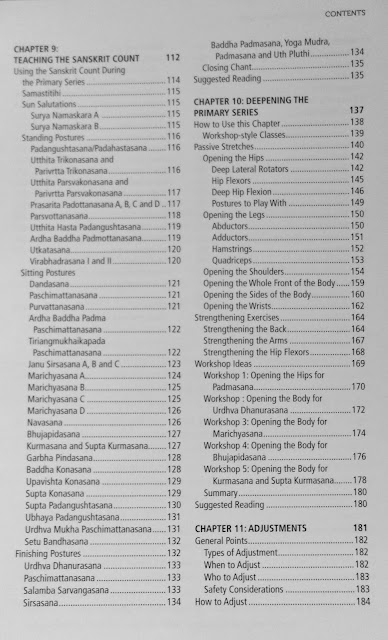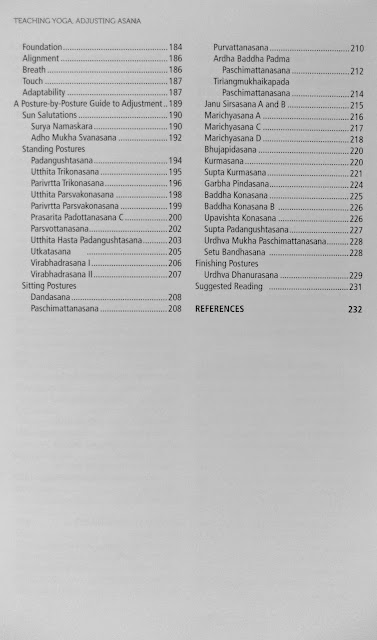Melanie Cooper (website http://melaniecooper.co.uk) got in touch recently and I asked if I'd be interested in reviewing her book Teaching Yoga Adjusting Asana. Melanie teaches in London, runs the Ashtanga self-practice 'Mysore' class each morning at the Life centre in Islington, London. We've never met but I had recently come across the book on Amazon, 'soon to be published', I'd put it on my wish list to have a closer look when it actually came out, I'd hoped for an Amazon LOOK INSIDE.
I've mentioned Amazon twice but it was actually Yogamatters (www.yogamatters.com) who ended up sending me a copy, so if your in the UK and would like a copy, here's the book on Yogamatters website. Yogamatters carry a wide range of stock, if you get the chance to make it up to their warehouse/shop, you'll be there for hours, browsing through their bookshelves, I was ( see my earlier post Inside Yogamatters UK Shop. Biggest yoga Bookshop in the UK?).
You should go, you really should because you can't seem to browse this book online, no preview on Yogamatters, no' Look Inside', as yet, on Amazon.
You get the cover...
and the brief outline from the publisher...
Leading yoga teacher trainer Melanie Cooper brings you the essential
handbook for teaching yoga and adjusting asana (yoga poses).
The first part explores fundamentals of teaching in a simple, clear, accessible way. Melanie covers how to teach crucial concepts such as breath, bandha and drishti, as well as more general topics including injuries, ethics and the spiritual aspects of yoga.
In the second part of the book there are helpful techniques for deepening common yoga postures and a complete guide to hands-on adjustment for the Ashtanga Primary Series.
With a wealth of information, clear writing, and fresh, detailed
photography, this is an invaluable resource for qualified yoga teachers,
student teachers, and yoga students who want to take their practice to
the next level.
Author: Melanie Cooper
Ringbound
Pages 244
£16.99
UPDATE
According to Amazon.com
9.1 x 6.5 x 0.7 inches
weight 1.2 pounds
$22.54
in English, Amazon.uk and Yogamatters
23.2 x 16.6 x 1.8 cm
350g
£16.99
but also offered on Amazon for £12.00 inc. postage
And that's it, oh wait, a little bio about Melanie herself.
Before I part with £16.99 I want to have a flick through a book, sit in the aisles and have a read..... I miss bookshops.
******************************
Anybody remember the recent Ashtanga opening chant article on Elephant Journal that seemed to be 'liked' and linked to all over fb earlier this month?
That was Melanie Cooper
and it there's a companion piece.
The Ashtanga Closing Chant - Elephant Journal
*
So lets have a look inside, here's the contents, some surprises...
Conclusions?
It's a good book, a lot of work gone into it, it's smart, you'd find a lot of stuff in here that you would use, whether your just starting teaching, going to a shala or practicing at home.
And best of all you can discuss/argue for hours it's basic premiss and whether Ashtanga should be taught in this way, the future of Ashtanga, whether it can survive in the gym scene or up against the gym scene for that matter.... or if everything beautiful about this practice becomes diluted and loses it's value.
Melanie is clearly an Ashtanga practitioner who loves her practice and devoted to it's communication. It's clear from reading her book that she believes Ashtanga can be taught in gyms and stay relevant and of value to those who come for practice however many times a week that may be.
BUT if Ashtanga can make the transition into gyms wouldn't this make it even harder for the smaller more traditional, Ashtanga six days a week, shalas to survive?
*
Melanie Cooper's website
*
So lets have a look inside, here's the contents, some surprises...
So far so good, straight forward teacher training material here, and it should be Melanie is an experienced teacher trainer. It's all clearly laid out with an intro to each section, 'Benefits', 'How to teach' it etc. If you were just beginning to teach and were looking for good clear explanations of these topics or more importantly how to communicate them without getting carried away, without saying too little too much and losing your students then this could be your teaching manual, it's ring bound too.
But now it gets, curious, Sanskrit count for Primary Series, a long section with pictures on deepening the Primary series and a long section on adjustments for Primary series.
This is a teacher training manual based on Ashtanga.
And that's curious because Ashtangi's don't do Teacher Training's (or do they), traditionally you keep going to Mysore, India in the hope that Sharath might give you the nod and then you can teach (although I believe there is money involved).
I've never really understood how that works, if Sharath says you can teach do you then just go and teach without any other training? No adjustments training ( Ashtangi's love to adjust), nothing on actually communicating the practice. Is it just assumed that you'll be able to teach Ashtanga?
Doesn't Sharath teach a few small workshops in Mysore for authorised Ashtanga teachers now?
I guess, in general, to be invited to teach by Sharath, you would have been practicing for seven to ten years, most likely at a shala and have been assisted/adjusted yourself throughout that time, you would have noticed what goes on in the Shala, watched your teacher, been on some workshops perhaps and watched those teachers too. You would have lived and breathed Ashtanga, studied your yoga Sutras, talked for hours about bandhas and Ujjayi, honed your yamas and niyamas...... And of course if your lucky you would have been offered a teaching assistant gig and received hands on training from an experienced Ashtanga teacher.
Melanie comments on this actually in the Introduction
"Before I go any further I want to state clearly that this is not about Ashtanga Yoga as it is traditionally taught in Mysore, and I'm not trying to give 'the correct Mysore point of view'. I have the utmost respect for Pattabhi Jois and Sharath and their teaching methods...... I do not pretend to speck for them and they have not endorsed this book.
I think that there is no doubt about the authenticity and integrity of Pattabhi Jois and Sharath. their teaching method has produced some of the most accomplished, knowledgable and sincere yoga practitioners around today, but the reality facing most new yoga teachers is that most of their classes are in gyms where it is not possible to teach in the Mysore style. Most of these classes are only one hour long and are open to all levels. Most of the students are practicing only once or twice a week. In this situation a new way of teaching Ashtanga has emerged - a general led class - and this is what teaching yoga, Adjusting Asana is about. But it is my hope that this book will be useful to many different categories of yoga practitioner".
On a side note, I can almost imagine Pattabhi Jois saying something similar on his first day teaching Yoga at the Sanskrit college, on why his presentation of Ashtanga was a little different from his teacher Krishnamacharya's presentation.
*
How useful is this book, should you buy it?
"...But it is my hope that this book will be useful to many different categories of yoga practitioner".
Whether your planning on teaching or not the book outlines, and in bullet points, many tricky concepts, bandhas, breathing, drishti, useful for the beginner perhaps and for anyone trying to explain these concepts in a way that works, by just saying enough. There is an good section on injuries and how to avoid them as well as onovercoming them, there's a section too on teaching the spiritual/philosophical aspect of the practice.
 |
| Drishti |
There is a section on the sanskrit count, handy if you've just come out of a led class, got confused in a few places but would like to go again next Friday, you can brush up.
 |
| Sanskrit Count |
 |
| Sanskrit Count |
I really liked this section on 'Deepening the Primary series', warm up exercises. I often include some extra Vinyasa Krama postures into my own Ashtanga practice at home to give myself a little extra work where necessary. There's also a section on some ideas for Workshops see the Contents screenshots above p169
 |
| 'Deepening the Primary series' |
The Adjustment section
This may well be one of the main reasons for your buying the book, it gets joint billing with Teaching yoga.
Teaching Yoga
Adjusting Asana
Before getting into the actual adjustments there are suggestions for trying them out on a friend, an old student perhaps, starting with simple corrections etc. Melanie outlines the types of adjustments , corrections, guidance, adjustments and which kind of students to use which type of adjustments on. There's are sections on when to adjust, safety considerations etc.
It's still problematic though isn't it. When I attended Manjus' teacher training course in Crete, there was a demonstration by Manju, then we were put into groups led by somebody who had already taken a course, all working ashtanga teachers actually. We would try the adjustments on each other, describe how they felt, get guidance form our more experienced group leader. Kristina would be working the room along with Manju, available for advice, suggestions, the slapping of hands and re demoing the assist. We would revisit the same assists the the next day and again the next, constantly re enforcing the teaching. Actually the assists too were mostly different from what I've found in this book, something to come back to in another post perhaps as I look more closely and try them out.
A book is no substitute for that. I imagine it's assumed that you would be attending an Adjustment workshop, perhaps one that Melanie takes herself, that this book is seen more as an accompanying manual to a course.
For the student it's nice to understand why your teacher is adjusting you in the way that they are, especially as there isn't a lot of verbal communication in a shala, this section would act as a good reminder too. For the home Ashtangi it gives us a way of looking at our own asana, we can use it to imagine what a teacher might be seeing, looking out for if they were there in our home shala.
Conclusions?
It's a good book, a lot of work gone into it, it's smart, you'd find a lot of stuff in here that you would use, whether your just starting teaching, going to a shala or practicing at home.
And best of all you can discuss/argue for hours it's basic premiss and whether Ashtanga should be taught in this way, the future of Ashtanga, whether it can survive in the gym scene or up against the gym scene for that matter.... or if everything beautiful about this practice becomes diluted and loses it's value.
Melanie is clearly an Ashtanga practitioner who loves her practice and devoted to it's communication. It's clear from reading her book that she believes Ashtanga can be taught in gyms and stay relevant and of value to those who come for practice however many times a week that may be.
BUT if Ashtanga can make the transition into gyms wouldn't this make it even harder for the smaller more traditional, Ashtanga six days a week, shalas to survive?
*
Melanie Cooper's website
 |
| http://melaniecooper.co.uk |






